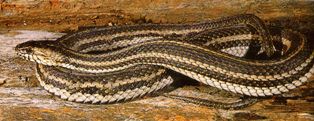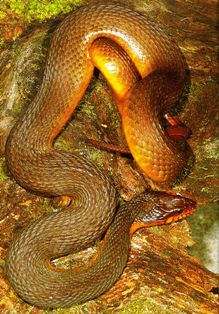Discover Florida Nature
It's time to explore the natural Florida


|
|
|
|
|
 Eastern
Mud Snake-
Mud snakes are found in the Coastal Plain of the southern United States
from southern Virginia south throughout Florida. Eastern mud snakes are
large snakes, reaching a length of 81 inches in adults. This highly
aquatic snake is seldom seen because of its secretive habits. Mud snakes
have a spine-like scale at the tip of their tail, and thus are sometimes
known as “horn snakes.” Male mud snakes are smaller than females but
have relatively longer and thicker tails. As adults, mud snakes feed
primarily on giant aquatic salamanders, such as
siren, but young snakes may also
consume other amphibians including salamander larvae and tadpoles.
Females lay eggs in early summer in sandy upland habitats near water and
sometimes attend the eggs until they hatch. Eastern
Mud Snake-
Mud snakes are found in the Coastal Plain of the southern United States
from southern Virginia south throughout Florida. Eastern mud snakes are
large snakes, reaching a length of 81 inches in adults. This highly
aquatic snake is seldom seen because of its secretive habits. Mud snakes
have a spine-like scale at the tip of their tail, and thus are sometimes
known as “horn snakes.” Male mud snakes are smaller than females but
have relatively longer and thicker tails. As adults, mud snakes feed
primarily on giant aquatic salamanders, such as
siren, but young snakes may also
consume other amphibians including salamander larvae and tadpoles.
Females lay eggs in early summer in sandy upland habitats near water and
sometimes attend the eggs until they hatch. Gulf
Salt Marsh Snake- Just as the name indicates, gulf salt marsh
snakes prefer brackish and saltwater estuaries, salt marshes and tidal
mud flats. The gulf salt marsh snake grows to a length of 15 to 30
inches. Distinguishing characteristics include two longitudinal tan or
yellow stripes on each side of the body, making up the dorsal (top)
pattern of the snake. It has a reddish-brown or grayish-black ventral
(bottom) color with one to three rows of large pale spots along the
center of the belly. This snake is flat headed. Small fish, crabs,
shrimp, and other invertebrates make up the diet of the gulf salt marsh
snake. Its predators include egrets, herons and crabs. As a way to avoid
predators, salt marsh snakes are nocturnal and often hide in shoreline
debris and in crab burrows in the mud or sand. The
gulf salt marsh snake does not have salt glands to help rid itself
of the salt it eats so it must be very careful not to drink salt water.
At three years, the gulf salt marsh snake reaches sexual maturity. Its
mating season is in early spring, and it gives birth to live snakes. Gulf
Salt Marsh Snake- Just as the name indicates, gulf salt marsh
snakes prefer brackish and saltwater estuaries, salt marshes and tidal
mud flats. The gulf salt marsh snake grows to a length of 15 to 30
inches. Distinguishing characteristics include two longitudinal tan or
yellow stripes on each side of the body, making up the dorsal (top)
pattern of the snake. It has a reddish-brown or grayish-black ventral
(bottom) color with one to three rows of large pale spots along the
center of the belly. This snake is flat headed. Small fish, crabs,
shrimp, and other invertebrates make up the diet of the gulf salt marsh
snake. Its predators include egrets, herons and crabs. As a way to avoid
predators, salt marsh snakes are nocturnal and often hide in shoreline
debris and in crab burrows in the mud or sand. The
gulf salt marsh snake does not have salt glands to help rid itself
of the salt it eats so it must be very careful not to drink salt water.
At three years, the gulf salt marsh snake reaches sexual maturity. Its
mating season is in early spring, and it gives birth to live snakes.  Mangrove
Water Snake-
The Mangrove Water Snake is found on the Florida coast from Miami to
around Cape Canaveral. It is not found outside Florida. The Mangrove
Salt Marsh Snake is variable in color and pattern and can be gray,
brown, olive green, or tan with faint darker banding. Some snakes are
almost all black, or solid reddish orange or straw color. There may be
dark stripes on the neck. The underside is variable in color - pale gray
on gray snakes, faded tan on brown snakes, mostly black on black snakes.
Juveniles are similar to adults. The Mangrove Salt Marsh Snake is mainly
active at night, but is often seen during the day basking above the
water on branches of
mangrove trees. Mangrove water snakes eat other smaller snakes,
including venomous snakes, and lizards. Mangrove
Water Snake-
The Mangrove Water Snake is found on the Florida coast from Miami to
around Cape Canaveral. It is not found outside Florida. The Mangrove
Salt Marsh Snake is variable in color and pattern and can be gray,
brown, olive green, or tan with faint darker banding. Some snakes are
almost all black, or solid reddish orange or straw color. There may be
dark stripes on the neck. The underside is variable in color - pale gray
on gray snakes, faded tan on brown snakes, mostly black on black snakes.
Juveniles are similar to adults. The Mangrove Salt Marsh Snake is mainly
active at night, but is often seen during the day basking above the
water on branches of
mangrove trees. Mangrove water snakes eat other smaller snakes,
including venomous snakes, and lizards. Rainbow
Snake- Rainbow Snakes are large snakes with red and black
stripes and smooth scales. They are powerfully muscled. Immediately
after shedding this snake is almost iridescent. Adult size is considered
to be in the range of 27 to 48 inches. The young are patterned like the
adults. This colorful water serpent is one of Florida's most beautiful
snakes, but it is rare and difficult to find. They are found in or among
floating vegetation in freshwater streams and sometimes in loose sand
along the banks of waterways and swamps.
Eels are reported to be their favorite food. This is a nocturnal snake
and is rarely seen in broad daylight. Rainbow
Snake- Rainbow Snakes are large snakes with red and black
stripes and smooth scales. They are powerfully muscled. Immediately
after shedding this snake is almost iridescent. Adult size is considered
to be in the range of 27 to 48 inches. The young are patterned like the
adults. This colorful water serpent is one of Florida's most beautiful
snakes, but it is rare and difficult to find. They are found in or among
floating vegetation in freshwater streams and sometimes in loose sand
along the banks of waterways and swamps.
Eels are reported to be their favorite food. This is a nocturnal snake
and is rarely seen in broad daylight. Striped
Crayfish Snake- The striped crayfish snakes are
mid-sized, highly aquatic snakes, ranging in size from 14 - 20 inches in
length. Striped crayfish snakes are an iridescent brown on top with
three darker stripes down the back. Its belly is a smudged yellow. They
are quite shiny, and their small tapered head and large eyes give them a
very unique appearance. The Striped Crayfish Snake is most common in
peninsular Florida and has only recently been found in a few locations
in extreme southern Georgia Crayfish snakes feed solely on crayfish and
dragonfly nymphs, hence their aquatic ways. Like many other aquatic
snakes, the striped crayfish snake can sometimes be seen crossing roads
on rainy nights. Striped
Crayfish Snake- The striped crayfish snakes are
mid-sized, highly aquatic snakes, ranging in size from 14 - 20 inches in
length. Striped crayfish snakes are an iridescent brown on top with
three darker stripes down the back. Its belly is a smudged yellow. They
are quite shiny, and their small tapered head and large eyes give them a
very unique appearance. The Striped Crayfish Snake is most common in
peninsular Florida and has only recently been found in a few locations
in extreme southern Georgia Crayfish snakes feed solely on crayfish and
dragonfly nymphs, hence their aquatic ways. Like many other aquatic
snakes, the striped crayfish snake can sometimes be seen crossing roads
on rainy nights. Redbelly
Water Snake- Red-bellied watersnakes are fairly large,
averaging 30-48 inches in length, semi-aquatic snakes. They are
generally dark brown, light brown, or grey with a bright orange to
yellowish, unpatterned underside. This beautiful snake is sometimes
called the Copperbelly. Juveniles are light brown to pinkish with dark
blotches on the back, alternating with blotches along the sides.
Redbelly Water Snakes are most at home in rivers and swamps and it is
usually a shy snake, fleeing into the water at the slightest
disturbance. Red-bellied watersnakes prey primarily on amphibians, but
will also eat fish. Because amphibians make up the majority of the diet,
red-bellied watersnakes tend to forage more in temporary wetlands,
because these habitats are breeding sites for amphibians. Redbelly
Water Snake- Red-bellied watersnakes are fairly large,
averaging 30-48 inches in length, semi-aquatic snakes. They are
generally dark brown, light brown, or grey with a bright orange to
yellowish, unpatterned underside. This beautiful snake is sometimes
called the Copperbelly. Juveniles are light brown to pinkish with dark
blotches on the back, alternating with blotches along the sides.
Redbelly Water Snakes are most at home in rivers and swamps and it is
usually a shy snake, fleeing into the water at the slightest
disturbance. Red-bellied watersnakes prey primarily on amphibians, but
will also eat fish. Because amphibians make up the majority of the diet,
red-bellied watersnakes tend to forage more in temporary wetlands,
because these habitats are breeding sites for amphibians. |
|
|
Advertise | Privacy Statement | Dog Encyclopedia | Video |Contact | Alaska Nature |
|